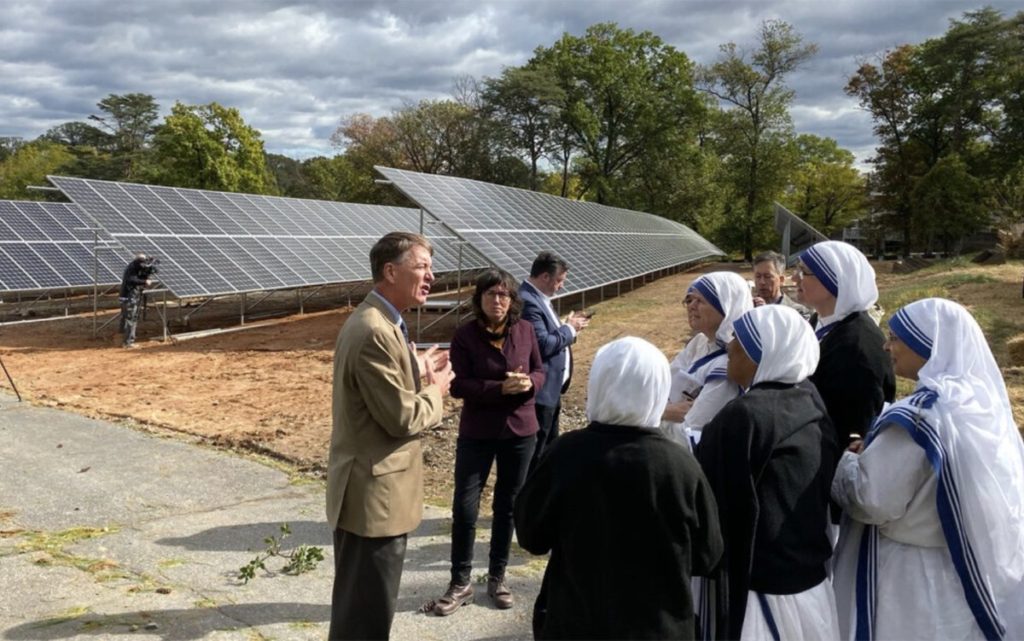Catholic organizations go solar to save money, and to put faith into practice

Catholic organizations own up to 100,000 buildings in the U.S., as well as land, and Catholic Energies is helping them go solar. “The market is enormous,” said the program’s leader.

Dan Misleh got the idea for Catholic Energies after Pope Francis called on Catholics to take up a “commitment to the environment” in his 2015 encyclical letter Laudato Si.
Misleh had been speaking to Catholic groups on climate, as executive director of Catholic Climate Covenant, and people would often tell him they couldn’t persuade their pastor, or their Catholic school principal, to talk about climate issues.
Figuring that “one thing that seems to motivate everybody is saving money,” Misleh launched the Catholic Energies program, and began talking about how a Catholic school could save $6,000 a year with an LED lighting retrofit.
Misleh teamed up with Dan Last, now a solar developer with Mission Energy, and the two ultimately persuaded four parishes in Ohio to adopt LED lighting. Yet reaching that agreement “took an enormous amount of work,” he said.
Over time, Misleh heard that “a lot of Catholic institutions wanted to look at solar.”
Now, with Catholic Energies having completed its first solar installation just 13 months ago, the program expects to reach 22 installations by the end of this year, with 11 in Virginia and the others across several states. The program can provide its services anywhere in the country.
Word of mouth
The nonprofit Catholic Climate Covenant, which runs the Catholic Energies program, does not advertise the offering, beyond mentions in its newsletter to 30,000 people, and through social media. The solar leads are generated through word of mouth.
The program’s largest project to date is a 2 MW solar installation in Washington, D.C. (image below) on a property where nuns in the Catholic order Missionaries of Charity—“Mother Theresa’s nuns,” said Misleh—provide hospice care.
To help with the facility’s finances, Catholic Charities of the Archdiocese of Washington had been considering selling some of the land, but “when we started talking to them about solar,” says Misleh, they decided to install a solar facility, “because D.C. is just a great solar market.” The project has reduced Catholic Charities’ energy costs, and is helping offset the cost of a new roof and windows for the hospice building.
When stories of this and other early projects “hit the airwaves,” said Misleh, “people started calling and it was off to the races.” The program recently announced solar installations on seven churches and schools in Virginia’s Diocese of Richmond, totaling 1.3 MW. Those solar projects, like most of Catholic Energies’ projects, will be financed through power purchase agreements.
Trust
The Catholic Energies team consists of Dan Misleh plus seven other team members who are employed by Mission Energy, Misleh said. Mission Energy is “pretty much working exclusively for us,” he added, and takes care of “all the technical aspects” of solar development, including arranging financing and selecting a contractor.
Catholic Climate Covenant is a national Catholic organization with ties to the U.S. Conference of Catholic Bishops, Misleh said. “So we’re a trusted entity. We’re looking out for the Catholic entity and trying to make sure that they are getting the best possible deal.”
Asked about a news report stating that a typical solar developer fee is 15%, Misleh said the Catholic Energies program “will take as low a fee as possible to get the project done. If a project looks feasible, but there’s no way that they can squeeze 15% profit out of it, then they’ll take less. And overall, over the portfolio of projects it’s certainly below 15%. I don’t know what the percentage is offhand, but it’s certainly lower. We’re not in it for the money. We’re in it to make this available to as many Catholic institutions as want it.”
Noting that some states and utility regions are less favorable for rooftop solar development than others, Catholic Energies sometimes advises Catholic groups to “wait until the market changes a little bit in your area.”
On the other hand, Misleh has found that some Catholic entities, “even if it costs more, will do it because they know it’s the right thing to do.”
Misleh’s role begins with bringing Catholic entities such as parishes, schools, and retreat centers to the solar market. Later, once a solar project has been built, he encourages the Catholic entity to educate its constituents: “so if it’s a parish, the parishioners; if it’s a school, the students, and maybe their parents; if it’s a healthcare facility, the employees of that facility.”
“The goal is to try to help Catholics understand church teaching on the environment,” he said. “We give them a very practical experience of how we can be better stewards of this gift we call creation.”
“Young people, generally, including young Catholics, are very concerned about the environment, and climate change in particular. So for some Catholic institutions, this is a witness for them. You know, we care about your future.”
Looking ahead
Catholic organizations own between 70,000 and 100,000 buildings, as well as land, Misleh said. The buildings include churches, schools, rectories, university buildings, and health care facilities. There is also “a lot of land available; we could do a lot more land-based solar arrays. So the market is enormous.”
Speaking of the difficulties in some states or utility regions in making solar “pencil out,” Misleh said his group could probably save Catholic organizations money with solar more widely, “if we could get financing to be less expensive.” With financing at a 5% return on investment, “we could probably put solar just about anywhere.”
Asked whether Catholic Energies might someday serve non-Catholic clients, Misleh said “We’re happy to share our model with other faith groups, other nonprofit entities, [to show] how we do this.”

